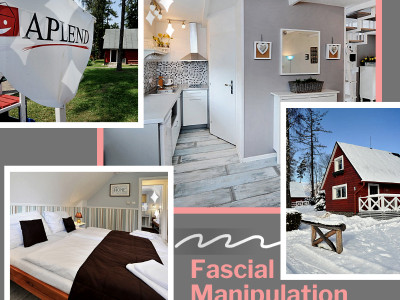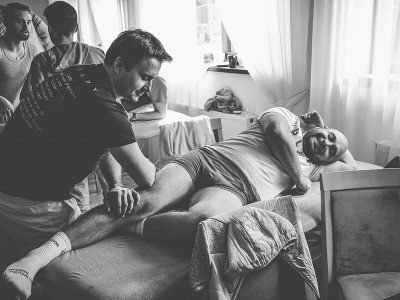Fascial Manipulations
úroveň primárny
Fascial Manipulation is a manual therapy method that has been developed by Luigi Stecco, an Italian physiotherapist from the north of Italy. This method has evolved over the last 40 years through study and practice in the treatment of a vast caseload of musculoskeletal problems.It focuses on the fascia, in particular the deep muscular fascia, including the epimysium and the retinacula and considers that the myofascial system is a three-dimensional continuum. Initially via collaboration with the Anatomy Faculties of the René Descartes University, Paris, France and the University of Padova in Italy and more recently with a host of different collaborations, Dr. Carla Stecco and Dr. Antonio Stecco have carried out extensive research into the anatomy and histology of the fascia via dissection of unembalmed cadavers. These dissections have enhanced the pre-existing biomechanical model already elaborated by Luigi Stecco by providing new histological and anatomical data
Multimediálne
O školení

It is hypothesised, that the richly innervated fascia could be maintained in a resting state of tension due to the different muscular fibres that insert onto it. Due to this optimal resting state, or basal tension, of the fascia, the free nerve endings and receptors within the fascial tissue are primed to perceive any variation in tension and, therefore, any movement of the body, whenever it occurs. Deep fascia is effectively an ideal structure for perceiving and, consequently, assisting in organizing movements. In fact, one vector, or afferent impulse, has no more significance to the Central Nervous System than any other vector unless these vectors are mapped out and given a spatial significance. In human beings, the complexity of physical activity is, in part, determined by the crossover synchrony between the limbs and a refined variability in gestures. Whenever a body part moves in any given direction in space there is a myofascial, tensional re-arrangement within the corresponding fascia. Afferents embedded within the fascia are stimulated, producing accurate directional information. Any impediment in the gliding of the fascia could alter afferent input resulting in incoherent movement. It is hypothesised that fascia is involved in proprioception and peripheral motor control in strict collaboration with the CNS.
Therapeutic implications
The fascia is very extensive and so it would be difficult and inappropriate to work over the entire area. The localisation of precise points or key areas can render manipulation more effective. An accurate analysis of the myofascial connections based on an understanding of fascial anatomy can provide indications as to where it is best to intervene. Any non-physiological alteration of deep fascia could cause tensional changes along a related sequence resulting in incorrect activation of nerve receptors, uncoordinated movements, and consequent nociceptive afferents. Deep massage on these specific points (CC and CF) aims at restoring tensional balance. Compensatory tension may extend along a myofascial sequence so myofascial continuity could be involved in the referral of pain along a limb or at a distance, even in the absence of specific nerve root disturbance. In clinical practice, cases of sciatic-like pain and cervicobrachialgia without detectable nerve root irritation are common (8).
This method allows therapists to work at a distance from the actual site of pain, which is often inflamed due to non-physiological tension. For each mf unit, the area where pain is commonly felt has been mapped out and is known as the Centre of Perception (CP). In fact, it is important to place our attention on the cause of pain, tracing back to the origin of this anomalous tension, or more specifically to the CC and CF located within the deep fascia.
Chcete sa dozvedieť viac?
Viac informácií nájdete v zdieľaných materiáloch po registrácii na tréning!
Moduly
- Fascial Manipulation I
- Fascial Manipulation II
Fascial Manipulation I
Level I - (6 days) includes fascial anatomy, introduction to Stecco's biomechanical model for the musculoskeletal system and initial training for therapists to treat common musculoskeletal dysfunctions. Emphasis on Myofascial Units, Centers of Coordination (CC) for unidirectional movements, balancing and proprioception
Fascial Manipulation II
Level II - (6 days) Completion of Level I is a prerequisite. Consolidates clinical application and introduces Centres of Fusion (CF) that are areas extremely important for proprioceptive dysfunction and complex movements.
Vydania
Miesto kurzu
Aplend Resort
Tatranská 4
059 91 Veľký Slavkov
Słowacja
Dodatočné informácie:
Miesto kurzu
Aplend Resort
Tatranská 4
059 91 Veľký Slavkov
Słowacja
Dodatočné informácie:
Vydanie 10
| Platba zálohy | 500 EUR | |
| Fascial Manipulation I 22.07.2024 – 27.07.2024 (Stefano Casadei) | 1000 EUR | Umiestnenia |
| Fascial Manipulation II 24.09.2024 – 29.09.2024 (Natalie Brettler) | 750 EUR | Umiestnenia |
Máte záujem?
Zaregistrujte sa teraz a získate prístup k tréningovým materiálom!
RODO
1) správcem Vašich osobních údajů je společnost SYNTONIC Dawid Kasolik ul. Jana III Sobieskiego 19, 32-650 Kęty. NIP: 549-236-83-97
2) Vaše osobní údaje budou zpracovány za účelem navázání kontaktu na základě: Čl. 6 odst. 1 písm. f obecného nařízení o ochraně osobních údajů ze dne 27. dubna 2016 (RODO) jako oprávněného zájmu správce
3) příjemci Vašich osobních údajů budou výhradně subjekty oprávněné získat osobní údaje pouze dle platných právních předpisů a také subjekty zabývající se zpracováním údajů
4) Vaše osobní údaje budou uchovávány po dobu 3 let
5) máte právo požadovat od správce osobních údajů přístup ke svým údajům, tyto údaje zneplatnit, odstranit nebo omezit rozsah jejich zpracovávání, jakož i právo na převod těchto údajů
6) máte právo podat stížnost dozorčímu orgánu
7) poskytnutí osobních údajů je dobrovolné, avšak odmítnutí tyto údaje poskytnout může být důvodem pro odmítnutí přijmout přihlášku





